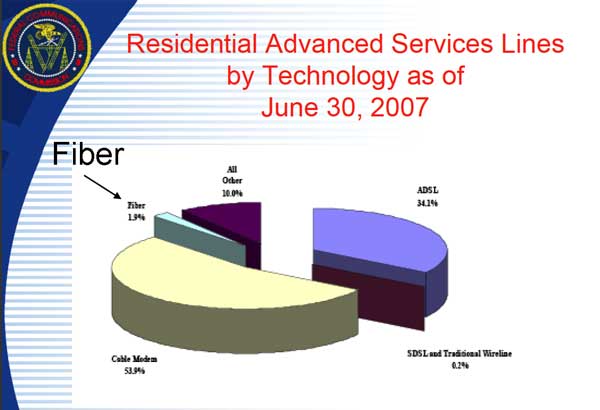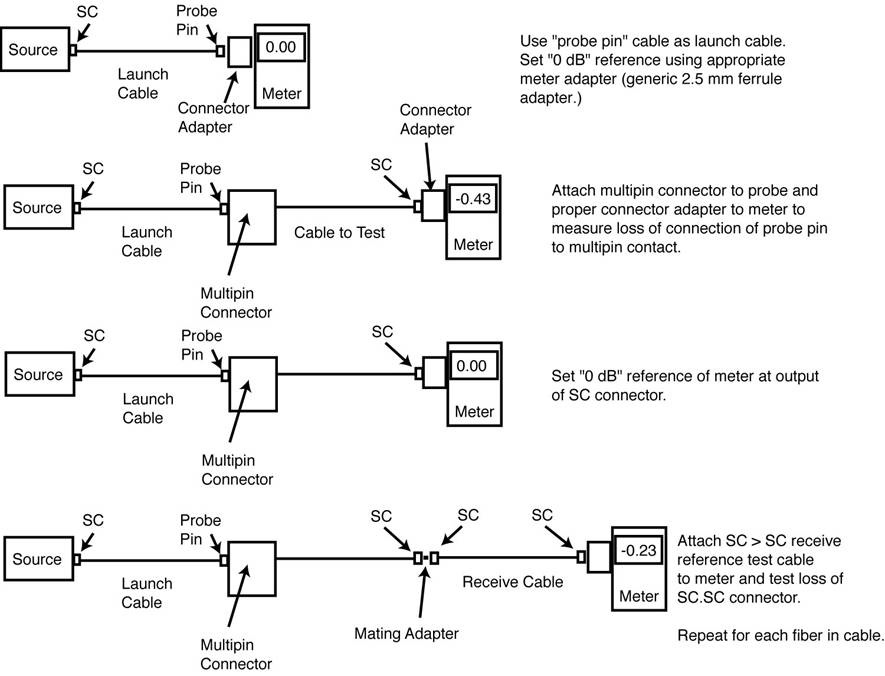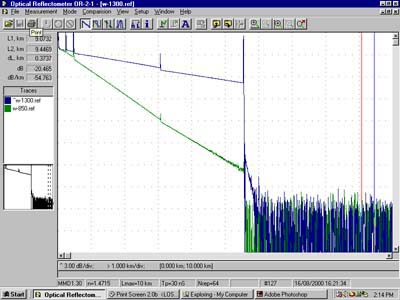

Applying For Broadband Stimulus $ Australia Opens Bids For Broadband Network Google Sees "Window" For PC Operating System Updated Certifications, CFOS Requirements FOA Updates Certifications Book From Reference Website FOA Online Fiber Optic Reference Guide It keeps expanding- now it will be published in book form - and "Google Custom Search" Tech Topics: New Listings of International Standards. See Tech Topics Below. Q&A: Testing a hybrid military cable. Product News: Motorola introduces LAN based on FTTH GPON. See "Product News" Below Worth Reading: Plenty of IT Jobs Even In A Recession? Cellular Wireless Needs More Backbone Capacity, iPTV Growing Fast. Cincinnati Bell Competes With Cable. See "Worth Reading" below
|
It's now CFOT® The FOA CFOT® (Certified Fiber Optic Technician) is now a registered trademark. With over 25,000 fiber optic techs holding CFOTs and the CFOT being recognized worldwide as the foremost certification in fiber optics, the FOA realized the value of the CFOT required trademark protection. Now it's official! Want to know more about fiber optics? Looking for specific information? Study for FOA certifications? Here's the largest technical reference on the web: The FOA Online Fiber Optic Reference Guide. Contact the FOA |
| You can now renew your FOA certification online - and get an extra month free. Details here. |
Miss us last month? We were much too busy to do a newsletter.  First we were working on a new FOA book, the FOA Reference Guide To Fiber Optics, which will be available this fall. It will be an updated book to be used in training for FOA certification and as a reference book for contractors, installers and end users of fiber optics. This book will be better organized than The Fiber Optic Technicians Manual and because we are self-publishing the book using more modern "publish on demand" technology, it will be easier to keep up to date and much cheaper! Our second issue last month was problems with the onlline database of installers, contractors and consultants. We have had to take the database off the website while we address the problems. So we have lots of news this month - read on! Applying For Broadband Stimulus $$? Better Get Moving! The National Telecommunications and Information Administration (NTIA) and the Rural Utilities Service (RUS) of the Department of Agriculture have announced two highly anticipated broadband-related programs funded through the American Recovery and Reinvestment Act of 2009 . RUS will distribute $2.5 billion “to expand access to broadband services” for projects where at least 75% of the affected area is in a “rural area” that lacks “sufficient access” to “high speed broadband service” to “facilitate rural economic development”. NTIA’s $4.7 billion share is for broadband initiatives that will “spur job creation, stimulate long-term economic growth and opportunity, and narrow gaps in broadband deployment and adoption”. NTIA’s the Broadband Technology Opportunities Program (BTOP) will be used to: deploy broadband infrastructure in unserved and underserved areas; enhance broadband capacity at public computer centers (e.g., schools, community centers, libraries, and other places that provide broadband access to the general public or “a specific vulnerable population”); and promote sustainable broadband adoption projects. All this and more is contained in the “Notice of Funds Availability” (NOFA) in the Federal Register: http://www.ntia.doc.gov/frnotices/2009/FR_BBNOFA_090702.pdf Applications for funding in this first round will be accepted from July 14, 2009 at 8:00 a.m. (ET) until August 14, 2009 at 5:00 p.m. Here is the link to the application process: http://broadbandusa.sc.egov.usda.gov/ Be aware that the Federal Register notice goes on for 120 pages and the application process will be detailed and time consuming. Have some time on you hands? Dive in and check it out – supposedly the application process is open to everyone. Workshops are being held in July - some are still available. Presentations are online at this link, where you can see how much fiber needs to grow.  Australia Opens Bids For National Broadband Network On July 1, 2009, the Australian government announced the first competitions for installing their national broadband network. Over 25,000 jobs are expected to be created in this program. Sounds like something we need in the USA. Lightwave. What's Up At Google? (cont.) Last month and the month before we discussed the impending entry of Google into the telephone business. This month's Google news was the announcement that Google will offer its own PC operating system next year to compete with "you know who" that will be optimized for "cloud computing" especially on netbooks, the simple, cheap portable computers. Based on Google's Chrome web browser, their operating system will be based on using online applications instead of programs in the computer. The timing for this could be perfect for Google. When first tried over a decade ago, it was much too advanced for most users and the capability of the Internet. Now the Internet and wireless links to PCs, both dependent on backbones of fiber optics, are ready - as are many users. Updated FOA Advanced/Specialist Certifications As part of the annual review process, the FOA enlists the assistance of dozens of experts to review our certifications and exams. That allows us to keep them up to date and even flag changes in our reference materials,and Online Reference Guide. We have made some changes that should interest our FOA members and schools. FOA CFOTs with the proper experience can now more easily apply directly to the FOA and, if qualified, take the certification exam online locally with a designated proctor. Manufacturers' training, e.g. testing, connector or splicing training, will qualify as experience. Shorlty, you will be able to study using an online study guide. If interested, download a FOA Logbook and document your experience. FOA schools should look at the CFOS certifications as the requirements for teaching classes has been clarified to include classroom and lab requirements. Now more courses will qualify for CFOS training, including, for example, OTDR training for CFOS/T or prepolished/splice connectors for CFOS/C. Check out the new CFOS page or contact the FOA for details. What are people saying about the new FOA CPCT Premises Cabling Certification covering fiber/copper/wireless? You have done a fine job, I found the test to be right on the money with today's need's. Questions were geared to real world applications. We needed this in the industry. This is only one of the reasons FOA certification shines. This is practical instruction for our industry. While most premises cabling certifications only cover "Cat 5" unshielded twisted pair (UTP) cabling, the FOA CPCT covers premises cabling the way it is being used today - not ten years ago! Now most premises networks use fiber backbones, UTP cables to the few desktops now being used and cabling to wireless access points for laptops and other WiFi- connected devices. Those who have experience in the field of premises cabling, even if they do not have a CFOT, can apply for the CPCT certification directly to the FOA. To facilitate preparing for the CPCT exam, the FOA has created the Premises Cabling section on the Online Reference Guide and created a CPCT Study Guide for the exam. FOA Online Fiber Optic Reference Guide New Book Based on the FOA Online Fiber Optic Reference Guide The FOA Online Fiber Optic Reference Guide has become very popular - perhaps the most popular technical website ever, typically with over 30,000 users monthly! Websites are great because they are available free to everybody and easily updated, but since many teachers need a printed textbook and others want a book to have for reference, we've created the FOA Reference Guide To Fiber Optics, a printed version of the techical materials on the website, organized for training and keyed to FOA curriculum materials. Based on lots of feedback from trainers at FOA-Approved schools and FOA members, we think you will agree this is the best FO reference for trainers, students, installers, contractors, and users ever. Coming Fall 2009. Wanted: Links To Technical Materials Next, we're soliciting links from fiber optic manufacturers and other organizations that have created technical materials that would be of interest to our readers. If you have technical websites you want to share, go here for our guidelines for submission. FOA Offers "Google Custom Search to Tech Topics and Online Fiber Optic Reference Guide  There's so much information on the FOA Tech Topics and Online Fiber Optic Reference Guide
that even a well-organized Table of Contents isn't enough and when the
material is always changing, an index is impossible to maintain. So the
FOA is using the latest technology in search, Google Custom Search,
which will allow you to search just the FOA Tech Topics and Online Fiber Optic Reference Guide for any topic you want to find more about. Try it! There's so much information on the FOA Tech Topics and Online Fiber Optic Reference Guide
that even a well-organized Table of Contents isn't enough and when the
material is always changing, an index is impossible to maintain. So the
FOA is using the latest technology in search, Google Custom Search,
which will allow you to search just the FOA Tech Topics and Online Fiber Optic Reference Guide for any topic you want to find more about. Try it! Go to The FOA Online Fiber Optic Reference Guide. Featured School: Good Question! Tech Questions Worth Repeating Followup: Q: We've got a hybrid military cable assembly with a multipin 38999 connector on one end and SCs on the other. How do we test it? The manufacturer gave us a SC to "pin probe" with a mating pin as a reference cable. A: Here a picture is worth at least a thousand words. The trick involved is to use two tests, one for each end of the cable, resetting the "0 dB reference" for each test. You need a meter or OLTS with adapters on the detector unless, as in this case, the pin is a 2.5 mm ferrule just like the SC, so a universal adapter will work.  OTDRs vs Fusion Splicing Machine Readings Q: When we fusion splice, the fiber machine shows splice losses of 0.00 to 0.04 dB, but tests with an otdr shows splice losses of 0.2 to 0.3 dB. Why? A: There are several issues involved. The splicer uses a profile alignment system (http://www.thefoa.org/tech/ref/termination/fusion.html ) that estimates the losses based on software estimates of how well the fibers are aligned. It's just an estimate, as it cannot actually measure the loss, and issues like differences in the mode field diameters or backscatter coefficients of the two fibers can make a big - and directional - difference in the losses measured by an OTDR (http://www.thefoa.org/tech/ref/testing/OTDR/OTDR.html). With the OTDR you should measure both ways with the OTDR and average. I suspect the larger losses could be directional issues with the OTDR and if you measure the other direction you will get lower losses. Measurement Uncertainty: Everyone testing fiber optics should understand that every measurement has some uncertainty - whether you are measuring loss, length, wavelength, power, etc. Knowing that uncertainty is very important to interpreting the measurement. It's worthwhile to read and understand the issue of measurement accuracy covered in this page of the FOA Online Fiber Optic Reference Guide. Worth Reading: Plenty of IT Jobs Even In A Recession? It seems that way. An article in the Washington Post points out the needs for skilled IT workers as spending especially in energy and healthcare are strong. The bad news is salaries are down. More. Cellular Wireless Needs More Backbone Capacity, iPTV Growing Fast Backbone build-out is urgently needed to keep pace with demand for video and other bandwidth hungry services. Growth of 15.2 percent is expected in 2009 alone. IPTV revenue will nearly quadruple from $5.3 billion in 2008 to $20.8 billion in 2012, a 40.8 percent compound annual increase. Overall voice, data and video revenue will reach $1.7 trillion in 2012, growing at a 5.9 percent compound annual rate.. TIA. TIA ICT Market Report. Cincinnati Bell Competes With Cable Cincinnati Bell Inc. is extending its ability to bring more than 250 TV entertainment channels and faster Internet service into apartment and condominium complexes across Southwest Ohio and Northern Kentucky at light speed. More. Good Technical Websites American Polywater (http://www.polywater.com/) has one of the best technical website for cable installers. Here is a rundown on some new material on their site. Cable Installation using "Push" or "Push/Pull" Polywater's new Pull-Planner™ 3000 Software allows a "pushing force" variable in pulling tension calculations. Read a White Paper that quantifies the push contribution and compares calculation results to field experience. -- http://www.polywater.com/pushing.pdf Pulling Cable Through Water? Read a Product Spotlight on Polywater® + Silicone™, Polywater's new generation underground lubricant. Continued reduction of friction when pulling through water is only one of the unique features of this lubricant. -- http://www.polywater.com/NNNBSL.pdf Check out their website, especially “Videos,” “Engineer’s Corner” and “Calculators.” http://www.polywater.com/NNNBSL.pdf  " Heard on the Street" is a monthly online newsletter from Frank Bisbee of Communications Planning Corporation that covers the telecommunications and cabling businesses. Each month includes news from manufacturers, trade associations and professional societies like the FOA. You can read the current issue and back issues online.  JDSU has announced the See the Light webinar series, a four-part program designed for anyone involved in the installation, maintenance, and repair of fiber optic systems. It begins with fiber inspection and cleaning and then covers the basics of fiber testing. The webinar series then continues with the more advanced optical time-domain reflectometer (OTDR) and fiber local area network (LAN) testing challenges. More information on the series. IGI, a major market research and technology reporting company (the "Active Optical Cables" below) is offering a a free one year subscription to one of our fiber optics newsletters to FOA members. All they have to do is to send IGI an e-mail stating which newsletter they would like to get. See http://www.igigroup.com/nl.html for a listing of IGI Newsletters. The new FOA reference website is now online. New sections have been added on fusion splicing and mechanical splicing. Check out the current Table of Contents. Coming soon to a network near you - 40 and 100 gigabit/sec Ethernet! The IEEE is already working on specs for 40 and 100 gigabit/sec Ethernet and have approved a number of new PMDs (that's standards-speak for Physical Medium Dependent - i.e. cabling). A summary of the proposals is on the updated list of network specs at http://www.thefoa.org/tech/Linkspec.htm.
Motorola Introduces LAN Based on FPON FTTH Network Motorola’s Passive Optical LAN (POL) system derives from the vendor’s experience supplying gigabit passive optical network (GPON) equipment for Verizon’s fiber-to-the-premises network. Motorola’s POL is an all-fiber enterprise LAN connecting any stationary Ethernet-based device or system across the enterprise into the wide area network. It supports cabled and wireless connections and is certainly something anyone looking to upgrade a LAN should consider. (One would assume that supplying millions of pieces of hardware to Verizon means they have gotten the price low!)  Read more from CED. Used Test Equipment – Buy or Sell http://www.testequipmentconnection.com/ Have you read the FOA Tech Topics on Cleaning? More links on cleaning: Cleantex Alco Pads Verizon Ups FiOS Speeds in NY Verizon is offering faster FiOS speeds in NY and even getting into the TV biz with a local channel. Telephony. In Norway, You Might Have To Bury Your Own Cable To Get FTTH! A Norwegian triple-play provider has a unique solution to the pesky problem of digging up consumers' yards to bury fiber-to-the-home. Lyse Tele, an overbuilder that launched its fiber-based all-IP solution in 2002, installs the fiber right to the edge of a customer's lawn, then gives the customer instructions on how to bury their own fiber cable to the house. Read More From Telephony.
|
What Is The FOA? Hear FOA President Jim Hayes tell the FOA Story in a 2-part interview by Sound & Video Contractor Contributing Editor Bennett Liles. It tells about the FOA history, goals and achievements. Part 1: http://svconline.com/podcasts/audio/fiber_optic_association_part1/index.html. Part 2 http://svconline.com/podcasts/audio/inside-fiber-optic-association2-0924/index.html. |
|
Digging Safely (Read the FOA Tech Topic) There is a new toll-free "call before you dig" number: 811 See www.call811.com for more information National Fiber Optic Protection Summit: By the "811" group. March, 2008 in Vegas.
|
|
|
Splicers - Canada (7/09) My company - Telco Direct Services Inc. Is currently under contract in Vancouver and the lower mainland and I require fiber splicers for approx 3 months possibly longer term. Rate of pay will be $40-50 depending on experience. Contact: telcodirect@shaw.ca Jeff Bondon - 647-892-6901 CEO Telco Direct Services Inc. Instructor/San Diego (6/09) "Private College looking for an Instructor to teach Cabling and Fiber Optic Classes". Part and Full time positions available. Campus located in San Diego, Contact Gary at 619.234.2181, Ext. 312 Do listings in the FOA Newsletter Work? Here's feedback: "We did great! We have over 15 interviews next week." Thanks, David Swales, Jr.
|
|

Your Name, CFOT - It pays to advertise! The FOA encourages CFOTs to use the logo on their business cards, letterhead, truck or van, etc. and provides logo files on this site for that purpose. But we are also asked about how to use the CFOT or CFOS certifications. Easy, you can refer to yourself as "Your Name, CFOT" or "Your Name, CFOS/T" for example. Feel free to use the logo and designations to promote your achievements and professionalism! |
|
Remember To Renew Your Certification ! Remember
to renew your FOA certification. All current CFOTs have a ID Card with
their certification data and we keep a database of current CFOTs to
answer inquiries regarding your qualifications if needed. You must be a
current FOA member and CFOT to participate in our online
database of installers, contractors, technicians and consultants.
If you forgot to renew, use the online application
form to renew NOW! You can now renew your FOA certification online - and get an extra month free. Details here. |
|
|
|